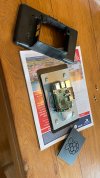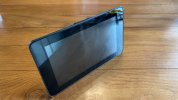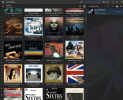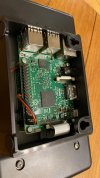antcollinet
Grand Contributor
At the request of Adam, here:
https://audiosciencereview.com/forum/index.php?threads/fan-less-silent-pc.41114/post-1487232
here is a short description of the Pi based streamer I built.
Components:
Raspberry PI 3b (Made redundant when I upgraded my media player to a PI4.
Official power supply
Official 7inch touch screen
OneNineDesign Raspberry Pi LCD Touchscreen Case
90degree micro usb connector for PSU connection.
SD Card
Approx. total cost including the pi is £130 to £140
The photos below show the Pi attached to the screen (case removed), and the fully assembled unit. The two wires connect the power from the pi to the display. As an alternative you can use two separate power supplies - one for the screen and one for the pi. Some people have reported power issues with the one supply, I’ve had no such problems.
Streamer software used is PicorePlayer
 www.picoreplayer.org
www.picoreplayer.org
PicorePlayer is a Logitech Media Server (LMS) and Player system. The software is open source, and there is an active user to user support community. You can either install the server, or the player or both. I’ve installed both on the same Pi.
Setup instructions on the site are not so brilliant. I used the video guide shown at the bottom of this post.
The software includes a web server which serves the PicorePlayer configuration web pages, the operation/control pages, and the LMS config pages. There are LMS control apps available (eg iPeng), but the built in control/operation web pages now seem to do as good a job. Even better it is possible to set up a link to that on my phone home screen so it appears just as an app with a mobile optimised display.
It is possible to stream your own files from a NAS (which I do) or add them to a local USB Drive (can be a pen drive) which can then be made accessible on the network for loading music. There is also support for some streaming platforms (Tidal, Deezer, Spotify and Bandcamp) (but not Amazon music), as well as many radio systems. I’ve added Radio paradise and BBC Sounds plugins. Sending to PCP via Airplay is possible.
Music output is via USB direct to my MiniDSP Flex
The thing works well. The only issue for me is I power off my media system when not in use, which includes the MiniDSP. When this happens, PicorePlayer loses the USB connection and needs to be rebooted. I cannot power off the PicorePlayer at the same time because, having the Database driven LMS Server built in, uncontrolled power off can cause data corruption and malfunction. I could solve this by setting up a second pi (ever a zero) as a server and leaving that powered on all the time, allowing me to remove power uncontrolled from the player pi.
One other thing to be aware of - the player operates fully from ram - so any settings changes need to be saved explicitly from the user interface, or they are lost nest time it is powered off.
Pictures and screen shots are below. A short video demo of the touchscreen is on youtube here:
Build pics










and Screenshots:



Setup Guide Video:
https://audiosciencereview.com/forum/index.php?threads/fan-less-silent-pc.41114/post-1487232
here is a short description of the Pi based streamer I built.
Components:
Raspberry PI 3b (Made redundant when I upgraded my media player to a PI4.
Official power supply
Official 7inch touch screen
OneNineDesign Raspberry Pi LCD Touchscreen Case
90degree micro usb connector for PSU connection.
SD Card
Approx. total cost including the pi is £130 to £140
The photos below show the Pi attached to the screen (case removed), and the fully assembled unit. The two wires connect the power from the pi to the display. As an alternative you can use two separate power supplies - one for the screen and one for the pi. Some people have reported power issues with the one supply, I’ve had no such problems.
Streamer software used is PicorePlayer
piCorePlayer
 www.picoreplayer.org
www.picoreplayer.org
PicorePlayer is a Logitech Media Server (LMS) and Player system. The software is open source, and there is an active user to user support community. You can either install the server, or the player or both. I’ve installed both on the same Pi.
Setup instructions on the site are not so brilliant. I used the video guide shown at the bottom of this post.
The software includes a web server which serves the PicorePlayer configuration web pages, the operation/control pages, and the LMS config pages. There are LMS control apps available (eg iPeng), but the built in control/operation web pages now seem to do as good a job. Even better it is possible to set up a link to that on my phone home screen so it appears just as an app with a mobile optimised display.
It is possible to stream your own files from a NAS (which I do) or add them to a local USB Drive (can be a pen drive) which can then be made accessible on the network for loading music. There is also support for some streaming platforms (Tidal, Deezer, Spotify and Bandcamp) (but not Amazon music), as well as many radio systems. I’ve added Radio paradise and BBC Sounds plugins. Sending to PCP via Airplay is possible.
Music output is via USB direct to my MiniDSP Flex
The thing works well. The only issue for me is I power off my media system when not in use, which includes the MiniDSP. When this happens, PicorePlayer loses the USB connection and needs to be rebooted. I cannot power off the PicorePlayer at the same time because, having the Database driven LMS Server built in, uncontrolled power off can cause data corruption and malfunction. I could solve this by setting up a second pi (ever a zero) as a server and leaving that powered on all the time, allowing me to remove power uncontrolled from the player pi.
One other thing to be aware of - the player operates fully from ram - so any settings changes need to be saved explicitly from the user interface, or they are lost nest time it is powered off.
Pictures and screen shots are below. A short video demo of the touchscreen is on youtube here:
Build pics










and Screenshots:



Setup Guide Video:









